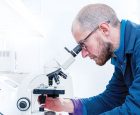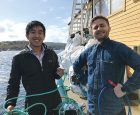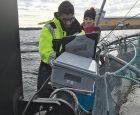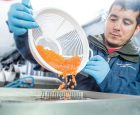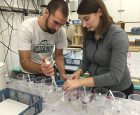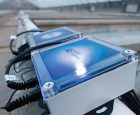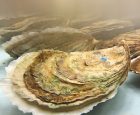
Features
Research
A look at new tech trends shaping aquaculture
From cloud computing to artificial intelligence, new technologies of the 21st century are not only changing the way people communicate, engage and conduct transactions, it is also dramatically transforming industries and making an impact on their growth and development.
January 16, 2019 By Mari-Len De Guzman and Liza Mayer
 Researchers at Hendrix Genetics explore new technologies to constantly improve and innovate its breeding programs.
Researchers at Hendrix Genetics explore new technologies to constantly improve and innovate its breeding programs. Some of these technologies are now widely applied and proving its worth in more mature industries, such as agriculture and transportation. For a young industry like aquaculture, these innovations can have huge implications on its evolution. The transition from manual operations to digital platforms can help significantly improve aquaculture farm production, management and risk mitigation strategies.
Hatchery International explores some of the trends in new technologies that are showing great promise for aquaculture operators around the world.
Environmental monitoring
Demonstrating the environmental sustainability of the industry through certification programs has served as a catalyst for some of the innovations that are transforming aquaculture. Sediment quality conditions and the robustness and abundance of marine life and macro-invertebrates beneath marine finfish cage aquaculture sites are indicators of a fish farm’s impact on the environment. The traditional method of assessing seabed diversity is time consuming, requires large quantities of formalin to preserve samples and requires an excellent taxonomic expertise, according to Mark Lane, executive director of the Newfoundland and Labrador Aquaculture Industry Association. Specialized labs or university researchers process samples taken by the farmers, but lack of trained taxonomists causes important delays in the analysis of rapidly growing number of samples. This seriously limits the efficiency of benthic monitoring, Lane says.
The recent development of next-generation sequencing (NGS) technologies is moving the industry toward more refined, efficient and effective monitoring. NGS technologies offer the possibility to use environmental DNA (eDNA) or RNA to explore benthic diversity. These methods have cut the benthic monitoring costs incurred by fish farmers and has made monitoring quicker and more accurate.
“It is also more environmentally friendly – the traditional sample preservation methods require huge amounts of a chemical called formalin,” Lane stresses.
He said this type of monitoring is currently not required by regulations, but it is required to become certified according to the Aquaculture Stewardship Council Certification. He believes the Canadian federal government is looking at it as a method to measure benthic communities for baseline studies at aquaculture sites.
Genomic selection
Breeding programs for fish and shellfish are aimed at increasing the profitability and sustainability of aquaculture. New hatchery technologies are being developed to enhance broodstock quality that can produce specific pathogen-free and fast-growing seed stock. The recent development of low-cost genomic tools is proving to be a game-changer for small hatcheries.
L’Étang Ruisseau Bar Ltd in New Brunswick, Canada, which has been producing and marketing Eastern oysters (Crassostrea virginica) for the past 30 years, attests to the benefits of these low-cost tools. “We now have the capacity to genotype individuals at thousands of markers simultaneously, at a reasonable cost (less than $30/sample). There is still a substantial cost in developing the marker set that’s suitable to use for selection, but fortunately there is a lot of interest from the research community in developing these tools,” says Martin Mallet, hatchery manager.
Genomic breeding, he says, has the potential to simultaneously accelerate genetic gains for traits of interest while minimizing inbreeding.
“It is being used successfully in agriculture. For us it means that small hatcheries with the right expertise have the potential to undertake breeding designs on a scale that simply weren’t possible before.”
He said it used to be impractical for small breeders selecting for certain types of traits (for example, traits that can’t be directly measured in the breeders) due to the large number of pedigreed progeny that must be tested to obtain reasonably accurate breeding values. But “genomic tools allow us to use phenotypic information more efficiently and greatly expand the scope of what is possible to achieve,” he adds.
Computer vision
Image recognition devices are proving to be a friend to breeding and genetics firms – particularly in phenotyping processes for genomic selection. Phenotype refers to the physical characteristics of an animal. It’s the sum of genetics and the environment, explains Robbert Blonk, director of research and development for aquaculture at Hendrix Genetics based in The Netherlands.
“It is much easier to phenotype animals in a digital, automated way,” Blonk says, “not only at one particular point or two during the lifetime of the animal but throughout its lifetime in the sea, for example.
“I need to have an accurate phenotype. I want to know exactly how many lice does the animal have on its skin, or how pink the fillet is… I need to be really precise with that information. This, plus the very accurate background information from genomics on the genetic architecture of a population at DNA level makes genomic selection more effective.”
Digital image analysis and computer vision systems can do the trick and provide more accurate data collection. These data will enable genetic researchers to find a relationship between genetic components and the final phenotype in a population – allowing them to select genetically superior animals, in whatever trait is of importance.
With precise phenotyping methodologies, researchers will be better able to develop a high-quality population of fish that are, for example, fast-growing, sea-lice-resistant and can perform well in different environmental conditions, Blonk explains.
Hendrix Genetics’ aquaculture business unit has been focusing extensively on salmon breeding since the 1980s. In recent years, the company expanded its scope – through several business acquisitions involving Troutlodge and Kona Bay – to include trout and shrimp to its portfolio. Last year, Hendrix completed the construction of a state-of-the-art, land-based breeding facility in Chile, with capacity to produce 45 million eggs, according to Blonk.
Hendrix Genetics is applying many of the innovations in salmon breeding, such as genomic selection and phenotyping, to its trout and shrimp breeding programs. “We are now bringing selective breeding of shrimp – and other species – to the same world class level as salmon.”
Computer vision technology is also finding its way into aquaculture management systems.
The use of so-called “aquabots” or remotely operated vehicles is not new in aquaculture but these technologies still rely on humans to monitor, analyze the data collected and make decisions based on their interpretation of that data. The development of computer vision and deep learning promises to help reduce the human element while helping farmers enhance monitoring, adopt more efficient growth methods, increase yields, and ultimately increase profit.
Aquabyte, a San Francisco, Calif.-based startup is applying computer vision and machine learning to help fish farmers determine biomass without having to handle the fish. Such knowledge helps farmers determine the optimal feed quantity. The software also looks for the presence and quantity of sea lice.
“I think we’re going to look back a couple of years from now and find it surprising that we’re growing fish but have no clue as to how big the fish is and consequently how much it needs to feed and how much the farmer has available to sell,” says Bryton Shang, founder and CEO of Aquabyte. “The company’s computer vision technology helps farmers understand the size distribution in the pen and use that information to better help grow the fish.”
Aquabyte’s software uses spatial and pattern recognition to identify anomalies in regular patterns. It is used alongside existing technology, in this case, an underwater 3D camera. “It does not require additional setup by the farmer, it’s very easy to set up and non-invasive,” Shang says. “What the customer gets is a dashboard where they can see the size distribution and sea lice counts. It is similar to reports that the farmer would normally be generating by hand.”
Through the application of its machine learning algorithms, Aquabyte anticipates that more-efficient feeding over a fish’s lifetime could result in potentially tens of billions of dollars saved in feed costs.
Cermaq’s iFarm is another example of the application of computer vision technology. iFarm is based on photo recognition of the fish and brings fish welfare and fish health to a new level, as each fish is individually monitored, says the Norwegian salmon farmer.
The technology monitors factors as growth, sea lice, disease, lesions and others aspects that affect the health and welfare of the individual fish. According to the company, it is possible to separate the fish that needs treatment, for example, against sea lice. This reduces the extent of sea lice treatments dramatically and “brings fish welfare to a new level by monitoring each fish in the pen,” the company says.
Sensors
Innovation in sensing technologies, coupled with computer vision systems, is changing the way farms are being managed. Water quality monitoring in land-based fish farms is one application. When used in conjunction with an online software tool for data management and analysis, the technology could spell the difference between life and death – literally.
Osmo Systems’ Osmobot sensors combine optical sensing with computer vision technology to collect water quality data that’s uploaded to an online management software system. Osmo Systems is the 2018 recipient of the Global Aquaculture Alliance Innovation Award.
“Our core belief is to innovate at the sensor level, specifically to bring aquaculture online,” says Zach Stein, CEO of Osmo Systems in Oakland, Calif., U.S.A. He adds the Osmobot provides a water quality monitoring system that is both “affordable and simple to maintain.”
Osmobot is a new kind of sensor that provides 24-hour monitoring of water quality in land-based aquaculture farms. Instead of probes, the system is built around sensor cartridges. When the cartridge interacts with the water in a tank or pond, the photochemical sensors attached to the cartridge will fluoresce or change color as an indicator of water condition. A camera inside the sensor then takes an image of the cartridge, measures and translates them into a reading. The data is uploaded into an online software tool and can be viewed by a farm operator from their smart phone. It allows operators to have a full view of the health of the species in the farm, enabling them to be proactive and take action before a situation becomes critical.
Stein believes technologies of the 21st century have the potential to shape the growth of the aquaculture industry, particularly for farming species that have yet to be fully understood from an aquaculture perspective, such as shrimp.
“If you look at tilapia or cat fish, they are hardier fish, they do better in changing water conditions,” Stein explains. “Shrimp is by far one of the largest species that has the highest demand – and it’s the most volatile. With shrimp, the code has not been cracked on how to create truly predictable yields. Being able to provide meticulous water quality data is a really important piece.”
The Osmobot system is slated to launch in 2019, with the capability to test for dissolved oxygen, pH levels, ammonia, and temperature. Development is underway to add salinity, water colour, carbon dioxide, nitrate and nitrite to the system’s measurement protocols.
Farm management with IoT
Many new industry innovations in recent years are based on the Internet of Things (IoT) platform. Put plainly, IoT is a network of electronic devices – personal gadgets, wearable devices, home appliances, office machines or industrial machinery and equipment – that are connected to the Internet. This Internet connectivity creates a huge network of devices that communicate with each other and with people.
This is already happening in the global agriculture market. According to a report by BIS Research, based in Fremont, Calif., U.S.A., the global IoT in the agriculture market will reach over US$28 billion in five years, with an annual growth rate of 14.15 per cent beginning in 2018.
“Integration of sensing systems into farming equipment has led to the generation of large amounts of data that can be analyzed using software tools, providing farmers valuable insights to promote yield growth,” a statement from BIS Research says.
In the aquaculture industry, imagine an interconnected network of devices – sensors, computers, tanks, grading equipment, fish counters, pumps, etc. – within a state-of-the-art fish farm, communicating with each other, sending and uploading critical data to a central command station, providing the operator a complete view of the entire facility. This is the potential for IoT in fish farming.
Devices such as the Osmobot and XpertSea’s XpertCount technology, which offers precision inventory assessment and quality analysis of farm species, are both Internet-connected devices that will form part of the larger IoT network. These devices are creating tons of data that can be a goldmine for production analysis and forecasting.
“The main driver for the aquaculture market to implement digital solutions (is to be able) to identify risks for fish health and welfare, to protect the biomass,” says Veronique Bourgier, IoT business development director at water treatment technology provider Veolia Water Technologies, headquartered in Paris, France.
Veolia is a significant player in the recirculating aquaculture systems (RAS) market, applying its expertise in water treatment technologies and aquaculture to help meet increasing global demand for land-based fish farms. The company has also embarked on offering farms the next step to bringing them further into the 21st century – a cloud-based, IoT-enabled farm management system.
AQUAVISTA is an IoT platform that relies on cloud computing to allow the merging of multiple data points from various devices and systems throughout the farm into a single management system. As the name connotes, AQUAVISTA provides a comprehensive overview of the company’s aquaculture production operations.
“We are able to use the cloud to remotely monitor the facility and create KPIs (key performance indicators),” Bourgier says. It connects to all devices and systems installed in the facility, including water quality sensors, SCADA systems, and other data sources.
The data generated by these devices are then uploaded to the cloud, allowing AQUAVISTA to create algorithms and KPI tools for farm managers. Based on KPIs identified by the customer, the system also has an emergency management feature that sends out an alarm or notification to the operator – wherever they are. It will provide recommendations that will allow the operator to make proactive decisions.
“It will maximize the efficiency of the fish farm,” Bourgier points out, “and reduce operational costs, especially in terms of management, maintenance and energy consumption. It will increase fish health and welfare, and boost production.”
Big data
As more farms go online, more and more devices are spewing out vast amounts of data that are all indicators of the overall health of the facility and the species that live in them. Industry innovators believe big data will become an important component for industry growth and even influence production yields. Predictive analytics, machine learning or artificial intelligence systems all require vast amounts of data to be able to process output and produce key leading indicators for the industry: production forecasting, disease control and management, feed management, environmental controls, energy efficiency, etc.
“Where big data will help in aquaculture is in two ways,” says Chuck Blumenschein, aquaculture business development manager at Veolia. “The predictive side of a ‘smart-RAS’ system will go beyond measuring water quality parameters and allow for enhanced operations. For instance, the system can monitor the trends in water quality relative to the feeding schedule, and recommend an adjustment to this schedule with the goal to improve utilization and water quality.”
Big data will also help future generations of fish farmers, Blumenshein adds. In-depth data analysis – through artificial intelligence capabilities – will provide operators a glimpse of the “future” of fish farms. “They will be able to use the data to create virtual fish farms and be able to test their decision-making abilities – it’s about de-risking future generations of fish farmers.”
Big data also has huge potential for innovation in breeding and genetics. Hendrix Genetics’ Blonk believes while innovation has been a big part of the success in developing high-quality genetics for certain species like salmon, other species still leave much to be desired. Big data will improve and speed up innovations in these other species.
“On the backs of genomic selection, we need more phenotypes, and we need more DNA information. These two will make genomic selection much more powerful, but at the same time we are getting more and more data. We need big data and artificial intelligence solutions to handle and analyze this data” Blonk says.
Even with more developed sectors like in salmon production, the ultimate goal is to be able to produce a population of fish that is not only resistant to sea lice, but can also thrive in varying environmental conditions – ensuring more predictable yields for fish farms. Big data can pave the way in the search for this proverbial holy grail.
Print this page
Advertisement
- RAStech 2019 brings global RAS experts under one roof
- Cermaq says salmon thriving in new closed containment system
